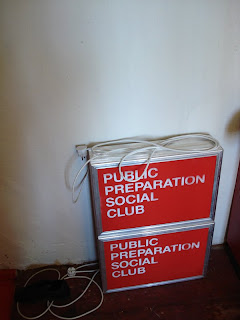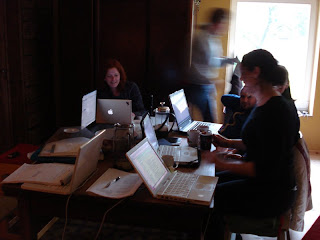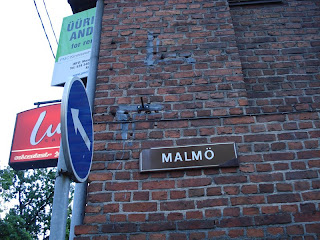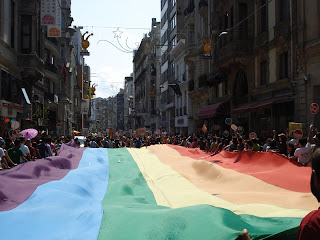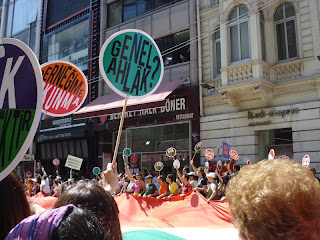Thursday, July 31, 2008
from "Data Recovery" publication Producing Dissent: Personal and Political Methodologies
In their 1988 book Manufacturing Consent: The Political Economy of the Mass Media, Edward S. Herman and Noam Chomsky mapped out the “propaganda model”: the intricate relations between mass media outlets and corporations, which lead mass media to filter certain information so that a public consent is manufactured. This process of “manufacturing consent” was responsible for shaping much of the discussion after 9/11. When the enemy is to be defined, mass media outlets are generally there to manufacture an anonymously approving public opinion. In the case of Iraq, we learned that, contrary to the insistence of the US and UK governments, there were no “weapons of mass destruction”. Recently, a newspaper revealed that some of the individuals presented as “political experts” on a number of news networks were employed by multinational corporations whose capital flow was impeded by Iraq’s then-regime. We know the story. Wars are increasingly waged on the level of information manipulation. The demon sitting at the information switch, as mentioned by Stephen Wright in his text Data’s Demon written for Data Recovery publication, actively participates in biopolitical control mechanisms, determining the borders of bare life; in the above mentioned context justifying Guantanamo’s existence for quite a long time in some people’s eyes.
Judith Butler gave a lecture in UvA Amsterdam in last March about possibilities of producing critique in academia. How new subjectivities can be created through active dissent came again to the foreground of discussion. Remembering Arendt’s underlining of civil disobedience as a moral obligation made me think one more time how it is not possible to even breathe today without taking a subjective political position, that it is an obligation more than ever. What is the role of contemporary art in producing active dissent? Many contemporary artists are interested in intervening into the borders between activism, social work, individual participation in political debates and creative production. The new subjectivity of artistic producers has turned the political potential of contemporary art into a common discussion.
While Data’s Demon switches on and off, it is not very suprising that processes of knowing and non-knowing become more involved with artistic strategies and researchas a new subjective position opening political potential to discussion in contemporary art. Particularly, artists -positioning themselves with changing realities and circumstances of the day- engage with recovering some certain histories untold and deliberately disregarded. They question the positions leaving some certain histories untold. Who produces and disseminates information? What makes a piece of information privileged or non-privileged? Why do some stay and some become part of the collective amnesia? How does knowledge production as such sustain some some political positions? And how can we dispute over that knowledge production?
For these concerns Jacques Rancière’s comment in the panel discussion "Artists and Cultural Producers as Political Subjects: Opposition, Intervention, Participation, Emancipation in Times of Neo-liberal Globalisation" that took place in Berlin in 2005 is published as part of this publication. Here, Rancière elaborates on the relationship between arts and politics by criticizing the strategies of certain documentary practices and 'relational aesthetics'. It has been observed by some that the comments he has given are what the art world wants to hear about itself. For me, he makes two important points in this speech: first he suggests the political is not the “outside,” the “real” that art would have to reach, that art should be politically committed to find; then he says “politics begins when there is a disagreement on the “reality of the real,” a dispute on the “given” itself”. He underlines the inherent criticality of artistic methodologies and points exactly towards the subjective position of producing dissent by disputing the given itself as a political potential in cotemporary arts rather than creating re-politicized parodies for the sake of being political.
Many of the knowledge producing activities initiated by artists dispute the “given”. How to confront and dispute the given, how to read against the grain of consensus? The artistic methodologies of research and process play a pivotal role here. Political potential performs itself almost as a double edged sword – it is so easy to fall back into a didactic well of witnessing, self-placating and trying to convince the audience about the political commitment of the artist. That’s why Data Recovery –as another exhibition that departs from the political potential of knowledge production – turns around the different artistic methodologies of the artists involved rather than using them for a certain conceptual illustration. The performance of covering is underlined here as a performative generic action word for the difference created by different artistic methodology as in the example of each artist’s covering the same song differently. They all work on the same notes and same original recording but the outcome is generally very different.
Methodologies make the difference; when the artists perform information in their work, it is not always the degree of politicness of that piece of information that creates the political potential but the twist coming with the artistic methodology. This performativity taking place, dirreneht reframings of the real as called by Ranciere, follows the changing, transforming characteristic of information. Just like Borges masterfully suggested in his well-known story “Uqbar, Tlön, Orbius Tertius”. In this well-known story, an encyclopedia article about a mysterious country called Uqbar is the first indication of Orbis Tertius, a massive conspiracy of intellectuals to imagine (and thereby create) a world: Tlön. In the course of the story, the narrator encounters increasingly substantive artifacts of Orbis Tertius and of Tlön; by the end of the story, Earth is becoming Tlön.
Recently, upon hearing about Data Recovery, a good friend asked “But isn’t everything performative these days, let along information?” referring to the current popularity of the term performative in contemporary art. Responding, I realized I’ve been thinking about my own daily relationship with information: receiving and writing e-mails, keeping an active blog to report about things I do and things I am interested in, reading certain blogs as part of my daily news updates, spending some hours in front of youtube watching diverse stuff and surfing across the information accumulated in wikipedia where I sometimes contribute. This online and casual information in transition, appearing as a sort of recording in transformation, happening and taking place, makes it impossible not to think of a performativity inherent to knowledge. While accesibility of this info-sphere in transition is providing us performative as a keyword, the situation is not a rose garden at all. Especially in countries like Turkey where spaces like youtube is constantly closed with court orders finding separatist and anti-Kemalist material online dangerous. Furthermore, one must not disregard another fact: Networking communities like facebook seemingly provides access but they are more used for scrutinizing privacy, tracing consumer habits and etc. Turkish army recently traced some number of men who were escaping from their obligatory military service through their info profiles on facebook.
Within these complex affininites of information in terms of its production, scrutinization, distribution and so called accesibility, my proposal or conceptual framework for Data Recovery takes its title from the performative process of salvaging data from damaged, failed, wrecked or inaccessible primary storage media when it cannot be accessed freely or simply gets lost. For me Data Recovery refers to illegal activities, attempting to break the distribution and production nodes. ”Can data get recovered?,” wonders Stephen Wright at the end of his text “Data’s Demon” and he says:
“Among the most forward-looking art practices today make use of the socially critical potential of data as an artistic material. Yet it is obvious that the aesthetic use of data – and of data tout court – is a eminently ambivalent phenomenon. For better or for worse, data makes things happen. But which is it? For better? Or for worse?”
This is a question for the visitor/reader to decide. Meanwhile let us elaborate on the works constructing Data Recovery to see how the exhibition produces its subjective position. Julie Ault and Martin Beck ‘s collaboration Information, a supersized wall mural, looks like a statistics chart that can be found in a sociology or economics textbook. The work gives an account of the history of the poverty measuring guidelines deployed by the U.S. government since 1964, merged with a graphic rendering of the increasing income gap between the wealthy and the rest of the American population over the past twenty-five years. Ault and Beck are interested in dismantling and building levels of analysis to process the relationship of art with information. The artists experiment with transforming a piece of social science information in an artistic format. Every Information mural is different and yet each of them is an accumulation of ongoing research since Ault and Beck update us with the recent changes in their data every time they are invited to create this mural. The artists actually take an existing piece of information into their hands- not something actually hidden but something not dissemminated, thereby reminding us the role of information in the politics of manufactured consent today.
While Ault and Beck activate their dissent about poverty policies in this artistic context, Michael Blum approaches the failure of the twentieth century systems from a witty and provoking angle in his essay performance video Three Failures (2006). In what he calls “a fairy tale about communism, social democracy and capitalism”, Blum brings together unexpected material about Sergei Eisenstein, Winston Churchill, Isaiah Berlin, Adam Smith and many others, weaving them into one story he performs in Malmoe, Riga and New York. As these cities merge into one bloc in our “global village”, this sequel to Wandering Marxwards (1999) keeps saying that all three phenomena -communism, social democracy and capitalism- are intermingled with each other, almost three faces of one story that fails. Michael Blum nourishes his critical position by putting himself on an ambivalent edge. What he does is more than what is on the cover; that is a playful take on these “failures”. By deciphering or re-reading the story inbetween the lines in his humourous way, he makes us question the positions from where privileged knowledge is produced and disseminated and reiterates the need to make personal and thus political re-readings of one’s own.
Vienna-based women art and media collective Klub Zwei’s work centers on critiquing dominant modes of representation and developing other approaches. In their new work Vaeter Taeter (2007), they choose to confront two women, Helga Haufbauer and Patricia Reschenbach, whose fathers were Nazi perpetrators. Interviewing Haufbauer and Reschenbach, they focus on the women's personal memories to trace what is missing in collective memory and especially how these two women’s lives are shaped by the past in terms of their identities, personal relationships and political sensitivities. Although we rarely see them personally in the work, we get to know Jo Schmeiser and Simone Bader of Klub Zwei through the framing of the shots and the intriguing and committed questions they pose. Their attempt to record personal histories of people living their lives today affected by National Socialism has built an exclusive body of artistic research in this field. Klub Zwei’s way of dealing with this history reflects their very personal way of political activism that shows itself with their different projects. For them, history is an actual and tactile series of images and stories to be re-presented.
Banu Cennetoglu’s site-specific installation Determined Barbara creates a temporary zone of occupation in the exhibition space to make the viewer confront the existence of Determined Barbara (“decisive” and “resolute” are also used in some reports on internet) - a SFOR [UN’s international peace forces]military training ground which displaced 704 inhabitants when it was built before the war in Glamoc in former Yugoslavia. Cennetoglu plays with the fictional language of documentary photography in this temporary occupation zone to communicate Barbara and the so-called stabilizing operations based there as a conflicting fiction created by a state of exception- that is peace stabilizing forces’ turning the villagers into refugees by their excepitonal right to provide and preserve peace. While Barbara turns peace into an ambiguity with its existence, for Cennetoglu – who conceived the series as a road trip between : Belgrade, Banja Luka, Sarajevo and Glamoc, the four cities that have a relationship with Determined Barbara – the performance of reporting itself becomes one of taking sides. Her deliberate way of impeding the distribution of the information she recorded is a part of artist’s “covering” methodology. The conceptual language she formulates points to a sharp awareness about the risk of dealing with “difficult matters” in the space of contemporary art.
Susanne Kriemann’s photography and text oriented work is driven by a critical curiosity about monumental structures as embodiments of ideology. In her own words, “the points of reference include the tension between historical objects and collective identities, and the re-contextualization of these objects within the space of the museum.” An intensive and intuitive research process lies behind each piece; she collects all the existing information about the objects of her curiousity before determining the format of the artistic outcome. The power of Kriemann’s work comes from this process and reaches its crescendo in the extraordinary transformation of that collected information. This time the centre of her attraction is Berlin’s 12,650,000 kilograms load test body “Grossbelastungskörper”, which was erected in the Tempelhof district as a commission by Albert Speer in 1941 and registered as a historical landmark since 1995. The publication 12,650,000 mimics the format of Artforum exactly and is accompanied by the artist’s photographic installation of the same name which is on display in Neue Nationalgalerie as part of 5th Berlin Biennial. Printed in only 100+10 copies, 12,650,000 opens with construction pictures of the object, repeats the same quoted image of “Grossbelastungskörper” for 380 pages and ends with the artist’s own photograph of the object in scaffolding again during official state renovation executed in 2007 and 2008. This complex and 1,6 kg “artistic edition” not only questions the value of the monument as an artistic object but also highlights Artforum as a market value determination tool displaying hundreds pages of artistic commercials.
Stockholm-based Goldin+Senneby define themselves as a framework for collaboration between artists Simon Goldin and Jakob Senneby dedicated to exploring notions of economic fiction and immaterial place. Working actively since 2005, they – demanding refreshed terminology for discursivity and research process- are engaged in an ongoing research practice, revealing its different steps at different places in various formats within an expanded time span. They claim that Looking for Headless is a process of constructing fiction and, at the same time, having the narrative play into the domain of the factual. What Goldin+Senneby stage operates as a catalyser creating the communicative, contextual, and most importantly, “performative” space of Data Recovery. It appears as a gesture of writing a meta-language for performative knowledge production, reframing fiction and the real and cross-texturing the fictitious non-spaces. For Data Recovery, they commissioned the writer John Barlow to write a crime mystery about Goldin+Senneby’s investigation into an offshore company in the Bahamas called Headless Ltd. And sent him to Bahamas to conduct the research for them. Barlow wrote a fictionalized travel journal about his findings and/or lack of findings in Bahamas, which will be a chapter of the novel Looking for Headless- a crime mystery based on Goldin+Senneby’s research process. And it will be Barlow himself, instead of Goldin+Senneby, coming to the opening at Gamec to be on stage with me, the curator of the project, talking about his Bahamas experience “looking for Headless”.
As final words, the exhibition will communicate itself more through its performative process space. In the mean time, I hope this publication will work as a good accompaniment.
Monday, July 28, 2008
n.e.w.s: north east west south
n.e.w.s. launches on July 28th, as part of ISEA 2008 from 19:00 to 22:00 @ The Substation, 45 Armenian Street, Singapore.
n.e.w.s. is a horizontally-organised, cumulative knowledge-based website for contemporary art and new media framed by curatorial contributions from around the globe, bringing together voices and images from North, East, West and South. n.e.w.s. reflects geographic diversity and facilitates a framework for collaboration, content and visions of change outside the normal parameters of the established art world networks.
Contributing curators and n.e.w.s. representatives will talk about building the platform, the way content is determined through curatorial positionings, and further collaborative tactics.
Contributors: Ade Darmawan/Ruangrupa, Ingrid Commandeur, Thomas Berghuis, Inti Guerrero, Mia Jankowicz, Rich Streitmatter-Tran, Mustafa Maluka, Stephen Wright, Yuliya Sorokina, and Branka Ćurčić/Kuda.
Moderators: Lee Weng Choy/The Substation, Renée Ridgway/n.e.w.s.
More about n.e.w.s.
 A tool for distributing immaterial resources and intellectual goods in an era of diversification, n.e.w.s. attempts to initiate, build and foster relations and provide a valuable portal dedicated to cultural bricolage, enabling less seen artistic endeavors worldwide visibility.
A tool for distributing immaterial resources and intellectual goods in an era of diversification, n.e.w.s. attempts to initiate, build and foster relations and provide a valuable portal dedicated to cultural bricolage, enabling less seen artistic endeavors worldwide visibility.
n.e.w.s. structures contributions in the form of Web 2.0 technology: a blog/archive (images and text), along with a wiki-like ‘books’ (collaborative writing), tagging (shared vocabulary) and polling. Content is curatorially determined: images, texts, podcasts and links provide information in the form of documentation of previous works or new media online.
Open-sourced, collaborative action and authoring are not only encouraged but also are integral to n.e.w.s. along with a community developed event calendar and database. Building upon shared knowledge and past references, contributors engage with each others’ practices. Multilingual translation, tagging and commentary will eventually contextualise the contributions and open up new possibilities, collaboration in the form of further projects as well as producing printed multilingual publications.
Comments and user feedback welcome! Please add your events to our calendar or subscribe to our mailing for further projects and announcements.
For more information please contact admin@substation.org
n.e.w.s. foundation: Sannetje van Haarst, Renée Ridgway, Tiong Ang
Middellandplein 35a2 3021 BW Rotterdam The Netherlands
life-o-life
colectivo situaciones, 2003
Sunday, July 27, 2008
dere'ce "data recovery" öngörüsü
manifesta sonrası gönüller roveretto'dan yana çarparken dere sanki adnan'la "data recovery"de olduğumuzu hissetmiş gibi bana bunu yollamış, ali'nin madenci figürüne yorumunu katmış.
bu arada kısaca
bir manifesta favorisi ragnar kjartansonn'dan schumann machine:
http://www.veoh.com/videos/v15121291ZZQDbQp2
after no connection days, news from friends first 1968-1989: summer seminar with Claire Bishop
1968-1989: summer seminar with Claire Bishop Museum of Modern Art in Warsaw, 28-30 July 2008 1968-1989 is a three-day seminar that attempts to investigate two key moments of political upheaval in terms of their impact upon the production and reception of art in Eastern Europe. Was 1968 in Eastern Europe the same watershed that it was in Western Europe? Should we consider 1989 to be a more decisive break and having more far-reaching consequences? One of the starting points for the seminar is the widely differing experiences of artists in Eastern Europe under communism: each country produced its own variant of official cultural policy, and produced different forms of artistic response to the dominant aesthetic of administered everyday life. Each country endured its own specific matrix of political restrictions that did or did not enable contact between Eastern centres and their Western counterparts. The seminar aims to compare and clarify these differences, paying close attention to the examination of specific works in particular contexts, revolving around the central question: how does political change manifest itself in works of art? Mon 28 July Internationalism Tue 29 July Participation Wed 30 July Exhibitions and Institutions
|
Muzeum Sztuki Nowoczesnej w Warszawie
ul. Panska 3
00-124 Warszawa
tel. +48 22 596 40 10
fax. +48 22 596 40 22
www.artmuseum.pl
Tuesday, July 15, 2008
out of place : interrogating silences in queerness/raciality
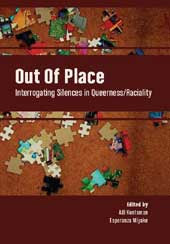
Out of Place asks daring and timely questions about the silence at the heart of queer studies. Discussing 'race' alongside 'queer' often submerges raciality within queerness, leaving racialised groups silent and silenced -'out of place'. Out of Place creates a space where queerness/raciality are brought together in creative tension to disturb these silences: to hear the invisible, to see the inaudible.
Out of Place takes the reader through an inspiring, illuminating and at times painful journey. The book explores queerness/raciality in the context of the 'war on terror'; corporeal and social practices in and of space;relations between visibility and politics; and cultural, literary, linguistic and theoretical mechanisms of translation. The papers in Out of Place cut across academic theory, arts, activism, the media and everyday life. All the contributors to Out of Place address queerness/ raciality as a theoretical and political tool to analyse and challenge their own fields, epistemologies and ontologies. This groundbreaking and fascinating book is not just about what happens at the intersection of 'queer' and 'race', but also about how this intersection relates to and animates other aspects of life.
"Out of Place is a bold collection of essays that teaches us to think about what happens and can happen at the points where queerness and raciality meet. These meeting points can be startling, powerful, violent, oppressive and enabling. From reflections on forms of violence, terror and security, to considerations of how whiteness coheres in space, from accounts of the life worlds of queers and trans of colour, to critical engagement with debates about methodology, experience and activism, this book brings together some powerful new voices.The landscape of queer and critical race studies might look quite different if we listen well."
Sara Ahmed
Professor in Race and Cultural Studies, Goldsmiths, University of London
Wednesday, July 9, 2008
he prefers sultans, he said
he remembers his first loves
he is loud and proud
he leaves for paris he sings hallelujah
he flies us to the moon
Tuesday, July 8, 2008
90'lardan bakmak: türkiye toplumunun bunalımı
Her toplumun kendine özgü ritm ve biçimde yaşadığı kültürel dönüşüm, Türkiye toplumunda, tarihi sıfırdan başlatmak isteyen, devlet gücüyle donanmış bir tahayyülün açtığı yaralarla kısa zamanda onarılması güç biçimde sakatlanmıştır. Bu nedenle, toplumun muhafazakarlığı, devletin onu yakın zamana kadar sürüklemek istediği, dış görünüşüyle Batı toplumundakilere benzeyen, ama içeriğine bakınca ne idüğü belirsiz olan değer ve kurumlara karşı bir direnişin ifadesidir. Ama bu açık bir direniş de değildir. Susup önüne bakma ve mümkün olduğunca bildiği gibi yapmaya çalışmak olarak tezahür eder. Bu nedenle toplumun dış görünüşüyle iç gerçeği arasında derin bir tezat bulunmaktadır. Bu tezat Türkiye'nin yaşadığı çağdaşlaşma sürecinin kendisinde vardır.
TC devletinin, çağdaşlaşmanın olmazsa olmaz ve hatta yeterli gerekleri olarak sunduğu siyasal prensipler, bir dış görünüm çağdaşlaşmasını hedefler. Çünkü asıl amaç çağdaşlaşmak değil, devletin toplum üzerinde yakından tahakküm kurmasını sağlamaktır. Bu tahakküm arzusuna tepki, toplumun büyük bir bölümünde bilinçsiz bir muhafazakarlaşmayı besler. Devlet çağdaşlaşma çaba ve tahayyülü ile Türkiye toplumunun bugünkü muhafazakar ve görünüşte içine kapalı tavrı arasında diyalektik bir bağ vardır."
Ahmet İnsel, 1990
Monday, July 7, 2008
süper bi fikrim var ya da acil demokrasi acil acil demekle oluyor mu
şöyle devam ediyor
'git bi daha geri gelme'
bitmeyen kontgerilla hikayeleri, kimin eli kimin cebindeler, hobisi darbe plani yapmak olan emekli generaller
ama tüylerimi en diken diken eden
bütün bu kavga arasında
dün ankara billboardlarında gördüğüm bbp posteri ve muhsin abinin gülen yüzü
hiçbir zaman hayra alamet olmayan
bilenler bilir
Thursday, July 3, 2008
son vakalar
okunmalı. bugün halihazırda üretim sıkıntısı yaşayan ortamımızda en derin ihtiyaçlardan, en derin yaralardan birine parmak basmıştır çünkü.
başka türlü bir güncel sanat yazımı. kendini açabilen, aşabilen, yeniden kurgulayabilen taze bir dil.
uzun lafın kısası
çıtayı yükseltecek eleştiriler yapacak eleştirmenler istiyoruz.
gerçi güncel sanatın tez olarak yazılmasını bile istemeyen bir akademik ortamda
bu iş nasıl olacak? eleştirmenler serada mı yetişecek orası da ayrı bir konu.
public preparation social club estonia

PUBLIC PREPARATION SOCIAL CLUB
Symptoms of nationalism and critique of nationalism in the practice of
contemporary art
Date: July 11, 2008
Venue: Pärnu Artists' House, Nikolai 27, Pärnu, Estonia
Info: www.publicpreparation.org
An international seminar in the series of "Public Preparation" events concentrating on the relations of contemporary art and nationalism in different places of the world.
The summer seminar furthers the current agenda of the "Public Preparation" project, continuing the thinking camp "Exercises on Adhocray" that took place in July 2007 and dealt with self-organisation and grassroots democracy in the field of contemporary art; it also follows discussions and debates from the international seminar "Translocal Express. Jubilee
Edition" which addressed the growing tendencies of nationalism on Eastern borders of Europe (from Helsinki to Istanbul) and its relation to contemporary art. Let's not forget, that during this year many European nation states celebrate its 90th anniversary -- these celebrations provide a vivid and indicative context to inspect and rethink the idea of nation
and nation state but also the role of art in these ideological constructions.
In the upcoming seminar a number of contemporary art professionals --artists, curators and art historians -- will give a comprehensive insight into the art scenes and dominant mentalities in the social realities they are active in. The aim of the seminar is to get an overview about diverse
cultural and artistic situations from the perspective of national values. The series of inputs could become a ground from which to continue with comparative analyses, mapping and examining of similarities and differences.
Presentations by Kendra Ballingall (Winnipeg), Remco de Blaaij (Eindhoven), Övül Durmusoglu (Istanbul/Vienna), Ronen Eidelman (Tel Aviv/Weimar), Eva Fotiadi (Amsterdam), Erden Kosova (Istanbul), Johannes Paul Rather (Berlin), Sára Stenczer (Budapest/Paris), and Tamara Zlobina (Kiev), moderated by Rael Artel (Pärnu).
Detailed programme is published at www.publicpreparation.org.
The seminar language is English.
For better management please register at info(at)publicpreparation.org.
Organiser: "Public Preparation"
Rael Artel
moskva80(at)moskva80.com
+37256229213
"Public Preparation" is an international platform for knowledge-production and network-based communication in the field of contemporary art. "Public Preparation" started in 2007 as a sequence of informal encounters which constituted the publicly visible preparation process of the Biennale of Young Artists, Tallinn 2007 (curated by Rael Artel & Anneli Porri). After the exhibition was over, "Public Preparation" continues as an independent project and focuses on the problematics of nationalism in contemporary society.
The seminar is kindly supported by Cultural Endowment of Estonia, Estonian Ministry of Culture, European Cultural Foundation, Manitoba Arts Council, Pärnu Town Government, and Winnipeg Arts Council.
Wednesday, July 2, 2008
Karri Kuoppala A DIEU
A DIEU
11.7. – 27.7.2008
Vernissage 10th of July 2008, 5 pm - 7 pm
Summerish music & etc. in the innercourt selected by My Spaceselector
at Helsinki City Art Museums Kluuvi Gallery
Unioninkatu 28 B, innercourt, 4TH floor, Helsinki, Finland
http://www.taidemuseo.hel.fi/suomi/kluuvi/ohjelma/kuoppala.html
Karri Kuoppala is the artist of the month of FRAME (Finnish Fund for Art Exchange)


